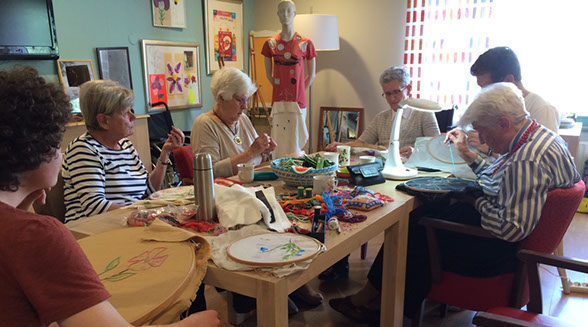GROWTH
WORK
USER & SOCIETY

The elderly care-home where I observed, interviewed and joined elderl in their creative activities during my B2.2.
I have always been interested in understanding how humans behave in society and how individuals think. I am good at observing, listening and understanding others. In my first years, I thought of the user as individual operator and society as a bigger system, but I missed the relation. During my B2.2 Research semester, I researched the role of creativity in elderly care homes. Connecting the perspectives and emotions of individuals to a big societal issue, social inclusion, made me see how design can connect individuals and society as part of their environment, from products to installations to services.
In three Human in Technology USE courses, I further analyzed the relation between people, the relation between people and the environment and the role of technology in these relations. In Design for Ethnography I learned when and how to use quantitative research methods to expose patterns and rarities in a context and motivate a decision with substantiated evidence. In projects after I found qualitative interviews and observation to be my preferred method; to understand user issues on a subjective level and create a design solutions rooted in experience.
Using interaction frameworks got me interested in the ‘homo sensorium’, sensory perception and experience on a bodily level. I followed Brain, Body & Behavior and Perception & Motor Control in the faculty of Psychology & Technology to develop a background in psychology. This excursion challenged me to relate that knowledge to design. For example, I explored applications of proprioception in Muziekmagneet.
Being very interaction focused, I entered courses that approached the role of design and technology in society. e.g. how data can give meaning to human desires in Digital Craftsmanship, sensing and exploiting changes in Trends and Forecasting and using design to influence societal thinking in Design for Debate and Socio-Cultural Sensitivity. These different takes on U&S made me sensitive to ambiguity in designing for a social context; see design as a way to research tensions between the individual and the collective, and start a dialogue with users.
A major step I made in my FBP was to involve users and experts as core of the process, which I explicitly learned by failing to do so in my first attempt at B3.2. Framing a clear user context helped me control the process and provided a common ground to define, evaluate and give purpose to the technology. More importantly, users and experts inspired me with their interpretations, showed me societal and user perspectives and found different meaning in my design. They provided input to create a richer interaction experience principles and advance the concept.
